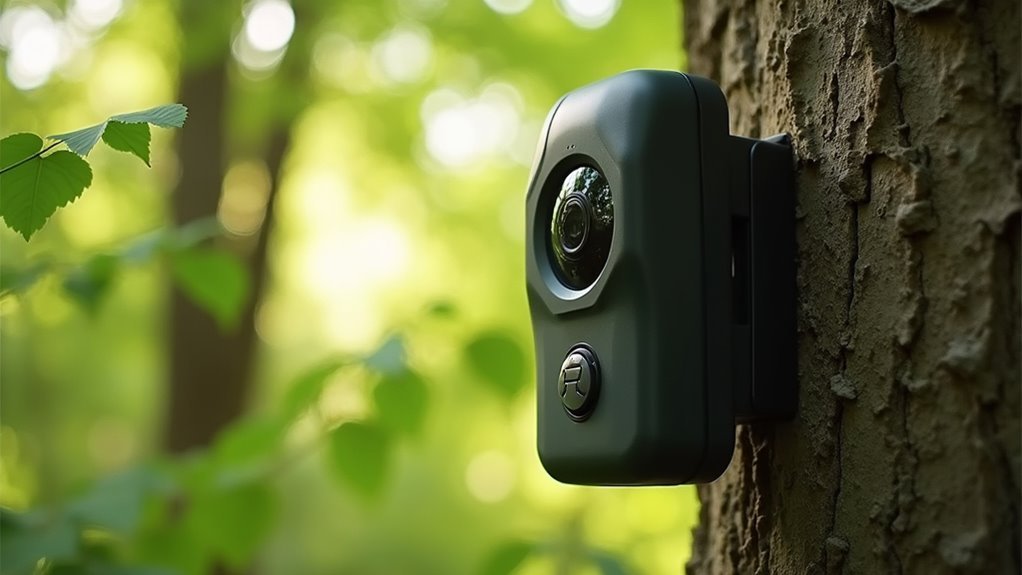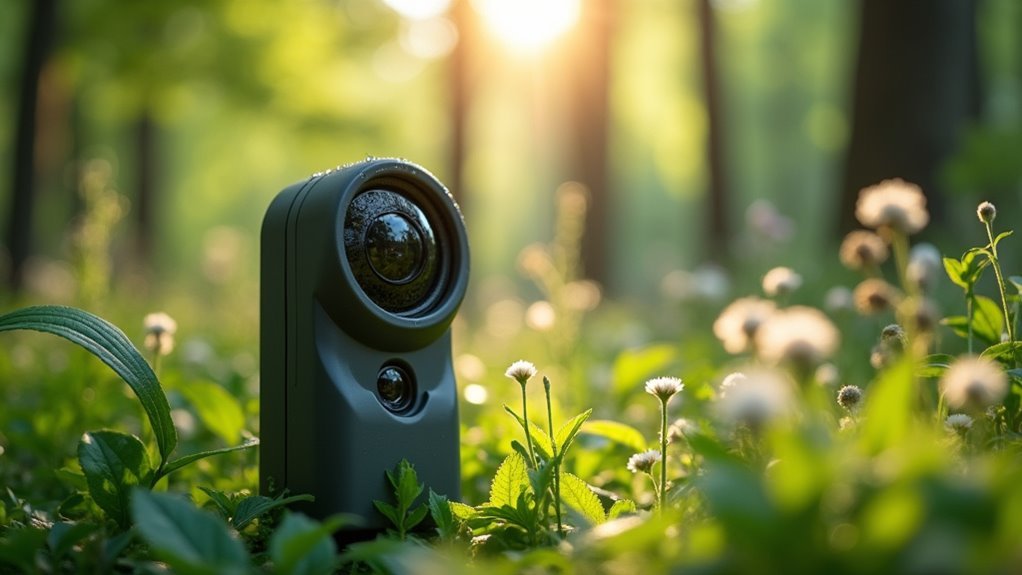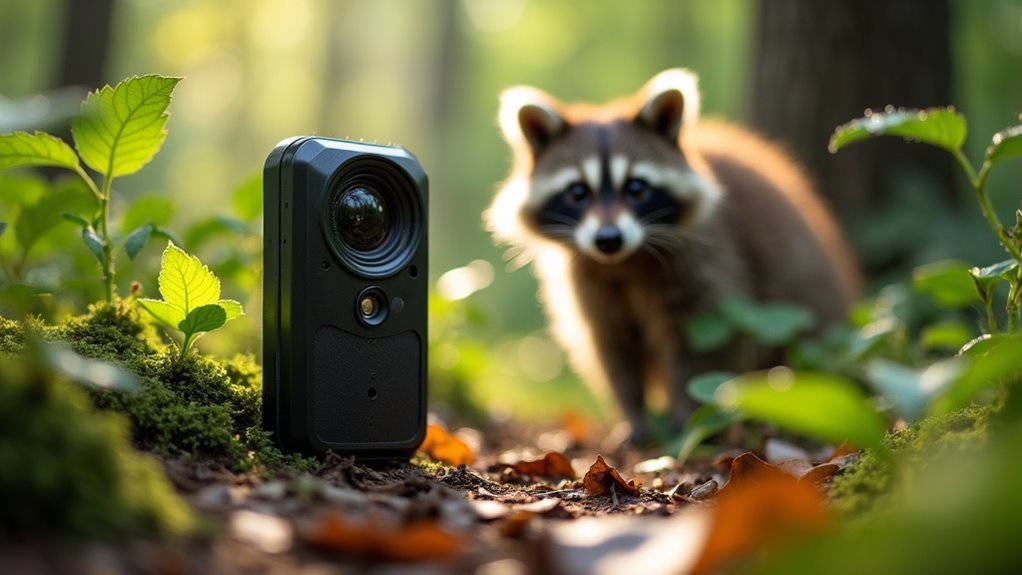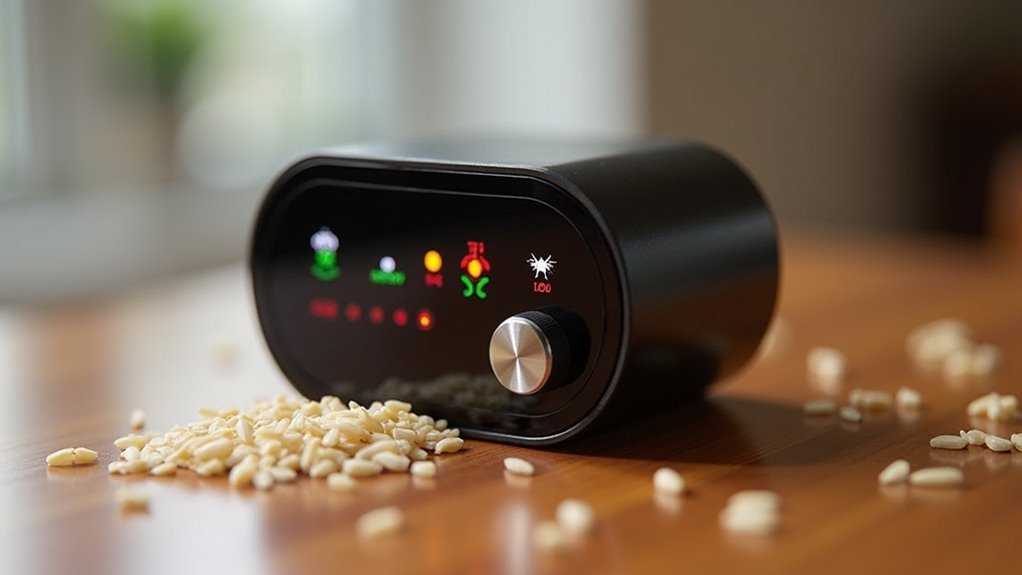You’ll want a motion-activated wildlife camera with 0.2-second trigger speed and infrared night vision to catch fast-moving pests around your property. Look for models like the Meidase P60 Pro ($59) or Wildgame Innovations Terra Extreme ($52) that offer 120° viewing angles, Wi-Fi connectivity, and 8-month battery life. Position cameras 3-4 feet high in shaded areas near pathways and feeding zones for ideal pest detection. The strategic setup and camera selection details below will maximize your surveillance effectiveness.
Understanding Motion-Activated Camera Technology for Pest Control

While traditional pest control methods often rely on guesswork and reactive measures, motion-activated wildlife cameras revolutionize how you monitor and identify pest problems on your property.
These sophisticated devices utilize infrared sensors that detect movement, triggering immediate image or video capture when pests enter the monitored area. You’ll benefit from their lightning-fast 0.2-second trigger speed, ensuring you won’t miss even the quickest pest activity.
The motion sensor wildlife technology operates continuously, providing 24/7 surveillance with automatic night vision capabilities.
Unlike intermittent monitoring methods, motion sensor wildlife cameras deliver round-the-clock pest surveillance with seamless night vision functionality.
Built-in Wi-Fi and Bluetooth connectivity let you instantly view captured footage through smartphone apps, while the 256GB storage capacity handles hundreds of files.
This technology transforms pest detection from reactive guesswork into proactive, evidence-based monitoring that confirms infestations and pinpoints their exact sources.
Key Features to Look for in Pest Detection Cameras
Now that you understand how motion-activated cameras work for pest control, selecting the right model requires focusing on specific technical features that maximize detection effectiveness.
You’ll want a camera with fast trigger speed around 0.2 seconds to capture quick-moving pests before they disappear. Look for wide viewing angles like 120° to monitor larger areas thoroughly.
Night vision capabilities with automatic IR filtering and high-power LEDs guarantee clear footage in low-light conditions when many pests are most active.
Wi-Fi connectivity enables real-time viewing and instant notifications through mobile apps, allowing prompt response to pest activity.
Choose models with microSD slots supporting up to 256GB storage for extensive recordings. These features optimize motion detection performance for effective pest monitoring.
Top Recommended Trail Cameras for Pest Monitoring

After evaluating numerous models, three trail cameras stand out as exceptional choices for pest monitoring applications.
The Bushnell Core S-4K No Glow Trail Camera ($150) delivers superior 4K video quality with quick trigger speeds, making it the premier trail camera for observing pest activity efficiently.
For budget-conscious users, the Meidase P60 Pro Trail Camera ($59) offers reliable motion detection up to 100 feet, though with slightly lower image quality.
The Wildgame Innovations Terra Extreme 14MP ($52) provides cost-effective pest monitoring with simple setup and user-friendly interface, despite limited customization options.
All three models operate on 8 AA batteries, lasting up to 8 months on standby, and feature Wi-Fi connectivity with microSD card support for instant photo viewing and real-time monitoring.
Setting Up Your Wildlife Camera for Optimal Pest Detection
You’ll need to focus on three critical areas to maximize your wildlife camera’s effectiveness in detecting pests.
First, you’ll position the camera strategically to capture the most activity.
Then, configure the motion detection settings for ideal sensitivity.
Finally, you’ll guarantee proper power management and storage capacity to maintain continuous monitoring without interruptions.
Camera Placement Strategy
Since effective pest detection depends heavily on strategic camera positioning, you’ll want to mount your wildlife camera at a height of 3-4 feet to capture clear ground-level activity while maintaining a thorough view of the surveillance area.
Your camera placement strategy should focus on high-traffic zones where pests naturally travel, such as pathways and feeding areas. Take advantage of the 120° fixed viewing angle by positioning the device to cover the widest possible range.
Choose shaded locations to minimize glare and enhance daytime image quality while ensuring unobstructed sight lines. Verify you’re within 2.4 GHz Wi-Fi range for real-time alerts through the TrailCam Go app.
Review initial footage regularly and adjust positioning to target the most active pest locations.
Motion Detection Settings
Proper motion detection settings transform your strategically positioned wildlife camera into a highly responsive pest monitoring system.
Set your trigger speed to 0.2 seconds for lightning-fast detection when pests move through the monitored area. This rapid response guarantees you’ll capture even quick-moving rodents and insects before they disappear from view.
Your camera’s 120° fixed viewing angle already maximizes coverage, but fine-tuning motion detection settings enhances performance.
Activate the automatic IR filtering with 34 high-power LEDs for crystal-clear nighttime footage without alerting nocturnal pests to the camera’s presence.
Configure sensitivity levels based on your target pest size – higher sensitivity for small insects, moderate settings for larger rodents.
These optimized motion detection settings assure you won’t miss vital pest activity evidence.
Power and Storage
When configuring your wildlife camera’s power and storage systems, the foundation of reliable pest monitoring begins with inserting 8 AA batteries that’ll deliver up to 8 months of standby operation. This extended power supply guarantees uninterrupted surveillance during critical pest activity periods.
| Storage Component | Specification | Benefit |
|---|---|---|
| MicroSD Card | Up to 256GB | Extensive recording capacity |
| Insertion Method | Easy slot access | Quick setup and maintenance |
| Video Recording | Real-time capture | Immediate pest documentation |
| Wi-Fi Function | Built-in connectivity | Instant photo viewing |
| App Integration | TrailCam Go | Streamlined footage management |
Position your microSD card for seamless data storage, enabling continuous recording without frequent transfers. The built-in Wi-Fi function connects to the TrailCam Go app, allowing instant access to captured footage and efficient pest activity analysis.
Strategic Placement Locations Around Your Property
Although wildlife cameras can monitor various areas, you’ll achieve the best results by focusing on specific zones where pest activity is most likely to occur.
Position your camera near entry points like gates, doors, and fences to catch intruders as they approach your property. Areas showing pest signs deserve priority—place cameras near feed storage, compost piles, or garden beds where animals frequently forage.
Mount your camera 3-4 feet high with a clear ground view, maximizing the 120° viewing angle for thorough coverage.
Use the built-in Wi-Fi feature to monitor live footage from your smartphone, enabling immediate responses to detected activity.
Rotate your camera regularly between different locations to gather extensive data on pest movements and identify hotspots throughout your property.
Night Vision Capabilities and Infrared Technology

Since most pest activity occurs during nighttime hours, your wildlife camera’s infrared technology becomes its most valuable feature for effective monitoring.
Motion sensors detect movement and trigger infrared LEDs automatically, capturing clear images without visible flash that might scare animals away. High-quality models feature up to 34 powerful infrared LEDs, providing effective illumination distances for thorough night coverage.
Your camera’s automatic IR filtering guarantees seamless switching between day and standard night vision modes. This technology maintains image clarity in complete darkness, allowing you to monitor pest behavior patterns you’d never observe during daylight hours.
Advanced models offer 1080p HD video resolution even in infrared mode, delivering detailed footage that helps you identify specific pest species and their movement patterns around your property.
Power Options and Battery Life Considerations
Power management becomes critical for wildlife cameras positioned in remote locations where frequent battery changes aren’t practical. This motion-activated camera requires 8 x size AA batteries, which you’ll need to purchase separately.
You’ll get impressive battery life with up to 8 months of standby time thanks to efficient power consumption design. For peak performance, you should use rechargeable NiMH or lithium-ion batteries instead of standard alkaline ones. These rechargeable options offer better cost-efficiency over time and perform more reliably in colder outdoor temperatures.
The camera’s microSD card slot supports extended recording without interrupting your monitoring sessions. Its weather-resistant design guarantees consistent operation across various outdoor conditions, making it reliable for long-term pest detection without constant maintenance visits.
Storage Solutions and Image Management
You’ll need to evaluate how much storage capacity your trail camera requires, with most models supporting microSD cards up to 256GB for extensive wildlife footage.
You can transfer your captured images and videos through built-in Wi-Fi using apps like “TrailCam Go” or connect directly via USB-C ports for computer downloads.
Modern trail cameras also offer cloud storage integration, letting you automatically backup and access your wildlife recordings from anywhere.
MicroSD Card Capacity
One major advantage of motion-activated wildlife cameras is their ability to support microSD cards with capacities up to 256GB, providing ample storage for thousands of photos and videos.
This extensive storage capacity means you won’t constantly worry about running out of space while monitoring pest activity around your property.
When choosing a microSD card for your camera’s microSD card slot, you’ll need to verify compatibility with your specific model.
Not all cameras support every card type or size, so checking specifications beforehand prevents potential issues.
Before using your new card, format it directly in the camera to guarantee peak performance and prevent storage-related problems.
You should also regularly review and manage stored content to avoid overflow situations that could cause you to miss capturing important pest activity footage.
File Transfer Methods
When it comes to transferring your captured wildlife footage, motion-activated cameras offer multiple convenient options that streamline the process.
You’ll find a USB-C port that makes moving data from your camera to computers or other devices incredibly straightforward. This direct connection guarantees fast, reliable file transfer methods without requiring additional cables or adapters.
For wireless convenience, the built-in Wi-Fi function connects your camera to your Wi-Fi network, enabling instant access through the “TrailCam Go” app. You can view and manage photos in real-time without physically accessing the camera location.
This wireless capability proves especially valuable when monitoring remote pest activity areas where frequent visits aren’t practical. Both transfer options guarantee you’ll never miss important footage while maintaining efficient workflow management.
Cloud Storage Options
While local storage provides immediate access to your wildlife footage, cloud storage solutions offer enhanced security and remote accessibility that transform how you manage captured images.
These cloud storage options require subscription fees but deliver significant advantages for serious pest monitoring applications.
Modern wildlife cameras integrate seamlessly with cloud platforms, automatically uploading your footage for safekeeping. You’ll gain real-time monitoring capabilities, accessing pest activity data from anywhere with internet connectivity.
Key benefits of cloud integration include:
- Automatic backup protection – Your footage remains safe even if cameras are damaged or stolen
- Remote image management – Monitor and organize captures from your smartphone or tablet instantly
- Real-time alerts – Receive immediate notifications when pest activity occurs
- Long-term storage solutions – Secure off-site archiving without local storage limitations
Interpreting Camera Footage to Identify Pest Species
Successfully identifying pest species from your trail camera footage requires systematic analysis of the high-quality images captured by the 8 Megapixel CMOS sensor.
You’ll need to examine details like body shape, size markers, and distinctive features that differentiate wildlife species. The 0.2-second trigger speed guarantees you’re capturing sharp images of quick-moving pests without motion blur.
Use the “TrailCam Go” app to instantly review and catalog your footage, creating an all-encompassing database of pest activity.
The 120° viewing angle provides wide coverage, capturing multiple angles for better identification.
When analyzing night footage, the 34 high-power LEDs and automatic IR filtering reveal nocturnal pest behaviors and physical characteristics that aren’t visible during daylight hours, helping you build accurate species profiles.
Weather Resistance and Durability Requirements
Since outdoor pest monitoring demands equipment that can withstand Mother Nature’s unpredictable moods, your trail camera’s IP-65 waterproof rating becomes a critical defense against rain, snow, and moisture infiltration.
Weather resistance isn’t just a feature—it’s vital for reliable pest detection in diverse environments. Your camera’s robust construction guarantees continuous operation despite harsh conditions, while efficient power consumption extends standby time up to eight months.
Key durability features you’ll benefit from:
- IP-65 waterproof protection shields internal components from moisture damage
- Battery-powered operation maintains functionality in remote locations without power sources
- Rugged construction withstands extreme temperatures and weather exposure
- Extended standby capability delivers months of reliable field performance
This weather resistance assures your pest monitoring system operates effectively year-round, providing consistent surveillance regardless of environmental challenges.
Cost-Effective Alternatives and Budget-Friendly Options
You don’t need to break the bank to capture quality wildlife footage with motion-activated cameras. Several affordable models under $60 offer reliable pest detection capabilities, while DIY solutions can stretch your budget even further.
Comparing essential features like trigger speed, storage capacity, and battery efficiency helps you identify the best value for your specific monitoring needs.
Affordable Trail Camera Models
Budget constraints don’t have to compromise your wildlife monitoring goals when you select the right affordable trail camera. Several excellent affordable trail camera models deliver reliable performance without breaking your budget.
Consider these top budget-friendly options:
- Wildgame Innovations Terra Extreme 14MP – At $52, you’ll get decent image quality with 40-foot detection distance, though customization options are limited.
- Meidase P60 Pro Trail Camera – For $59, this model offers impressive 100-foot detection range, but image quality decreases at maximum distances.
- Bushnell Core S-4K – Around $150, it provides superior 4K video quality and exceptional image clarity for pest detection.
- Essential features – Look for models supporting up to 256GB microSD cards, 8-month battery life, and 8 AA battery compatibility for extended monitoring periods.
DIY Motion Detection Solutions
While commercial trail cameras offer convenience, building your own motion detection system can slash costs while providing greater flexibility for your specific wildlife monitoring needs.
You can create effective setups using Raspberry Pi or Arduino with motion detection modules for under $100. These platforms automatically capture footage when movement triggers PIR sensors, giving you complete customization control.
| DIY Component | Emotional Impact |
|---|---|
| Smartphone apps + Wi-Fi cameras | Excitement of repurposing existing devices |
| Outdoor security cameras | Peace of mind with weatherproof reliability |
| PIR sensors + basic cameras | Pride in building from scratch |
Simple PIR sensor configurations detect infrared motion changes, triggering cameras to record wildlife activity. Smartphone apps can transform old devices into motion-activated observers, sending real-time alerts. These budget-friendly solutions provide specialized monitoring without expensive equipment investments.
Budget-Conscious Feature Comparisons
Three standout budget trail cameras prove you don’t need to spend hundreds for effective wildlife monitoring.
When you’re budget-conscious, the Wildgame Innovations Terra Extreme 14MP at $52 delivers simple setup and user-friendly operation, though daytime images may appear pixelated.
The Meidase P60 Pro Trail Camera ($59) offers reliable action capture with 100-foot detection distance before discontinuation.
Key budget-conscious considerations include:
- Limited customization – Both models restrict settings to basic date/time and still/video options
- Battery optimization – Choose rechargeable NiMH or lithium-ion batteries for better cold weather performance
- Image quality trade-offs – Expect lower resolution compared to premium models
- Budget stretch option – Bushnell Core S-4K ($150) provides superior quality with two-year warranty
These affordable options prioritize simplicity over advanced features while maintaining effective pest detection capabilities.
Frequently Asked Questions
What Is the Difference Between a Trail Camera and a Wildlife Camera?
You’ll find trail cameras focus on long-term wildlife monitoring with extended battery life, while wildlife cameras emphasize real-time connectivity and live streaming through smartphone apps for immediate observation of your surroundings.
What States Have Banned Trail Cameras?
You’ll find trail camera bans in Arizona, Montana, and California, with restrictions during hunting seasons. New Mexico prohibits them for big game hunting specifically, while other states continue evaluating regulations for fair chase practices.
How Far Away Can a Trail Camera Detect Motion?
You’ll find most trail cameras can detect motion between 70-100 feet away. Your camera’s detection range depends on its specific model, settings, and environmental factors like vegetation that might obstruct the sensor’s view.
Can I Use a Wildlife Camera as a Security Camera?
You can absolutely use a wildlife camera as a security camera. They’ll provide high-resolution footage, motion detection, night vision, and weather resistance, making them excellent for monitoring low-traffic outdoor areas effectively.
In Summary
You’ll find motion-activated wildlife cameras transform your pest management approach when you choose the right features and placement strategies. Don’t overlook weather resistance and storage capacity – they’ll save you headaches later. Start with budget-friendly options if you’re testing the waters, then upgrade as your needs become clearer. Remember, proper positioning beats expensive equipment every time. You’ve got the knowledge now; it’s time to protect your property effectively and efficiently.




Leave a Reply